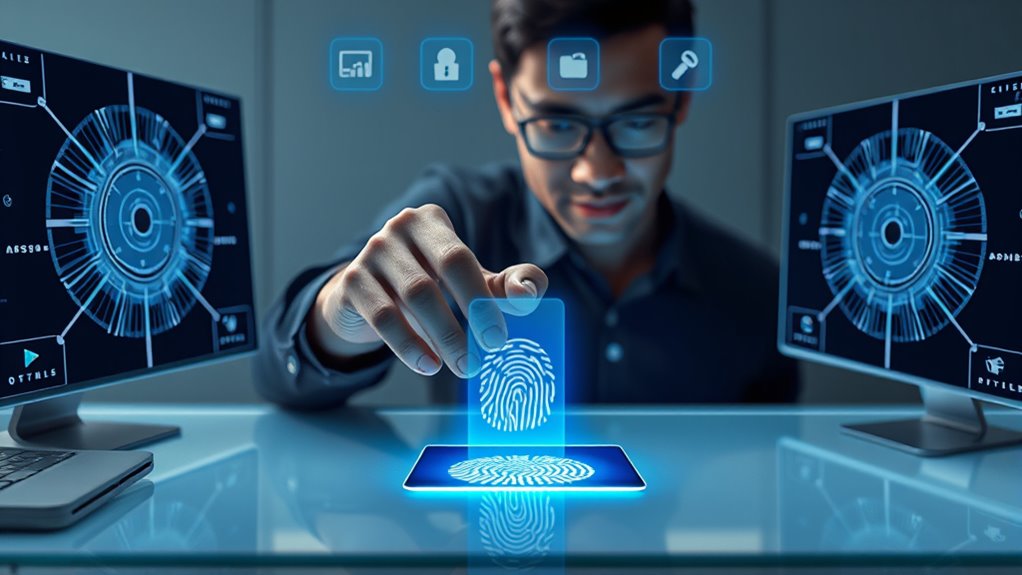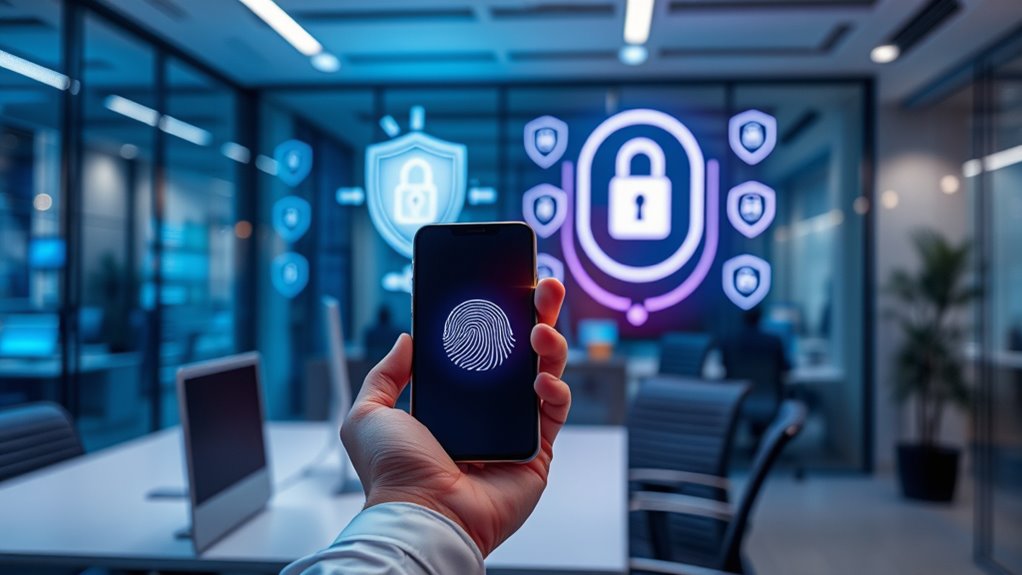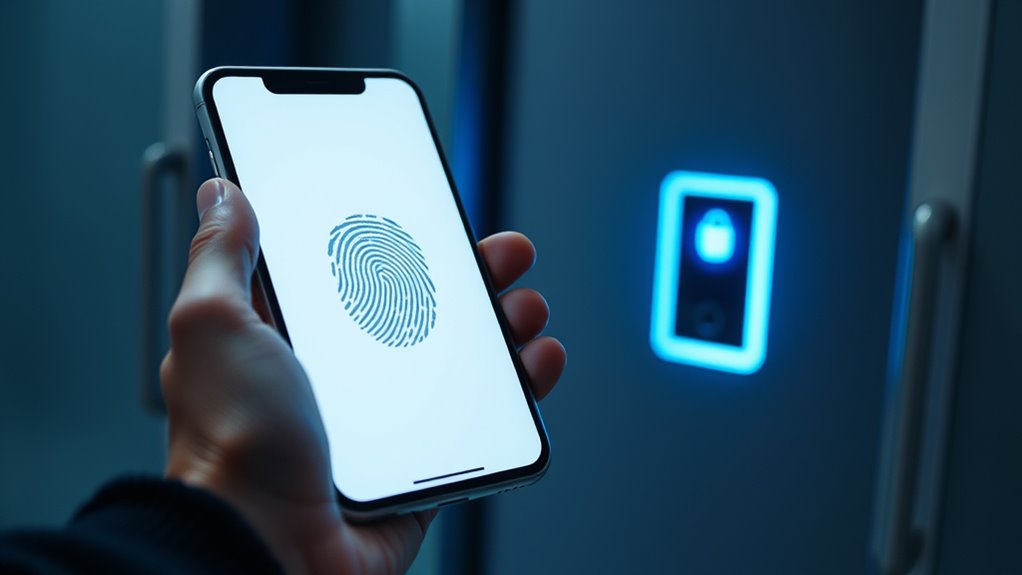The rise of passwordless authentication means you can now access digital services more securely and conveniently by using biometrics like your fingerprint, face, or voice instead of traditional passwords. This method reduces your vulnerability to hacking and phishing attacks, while offering smoother logins. Advances in AI and cryptography further strengthen these systems. As this shift continues, you’ll discover how these innovative solutions can protect your data and simplify your digital life.
Key Takeaways
- Passwordless authentication enhances security by using biometric and cryptographic methods, reducing reliance on vulnerable passwords.
- Technologies like facial recognition, fingerprint, and behavioral biometrics enable seamless, user-friendly access experiences.
- Transition from traditional passwords to passwordless methods improves protection against phishing, hacking, and data breaches.
- Implementation involves cryptography protocols, multi-factor authentication, and device recognition, ensuring secure digital interactions.
- Future trends include biometric advancements, quantum encryption, and decentralized identity systems, further strengthening cybersecurity.
Understanding Passwordless Authentication and Its Benefits

Passwordless authentication is transforming the way you secure your digital identities by eliminating the need for traditional passwords. Instead, you rely on methods like voice recognition, where your unique voice patterns confirm your identity effortlessly. This approach enhances security because voice biometrics are difficult to replicate or steal. Additionally, multi-factor authentication (MFA) adds a layer of protection by requiring two or more verification factors, such as a fingerprint and a voice command. These methods make it easier for you to access accounts quickly while reducing the risk of hacking or phishing attacks. By adopting passwordless techniques, you experience a more seamless, secure login process that minimizes frustration and maximizes protection. It’s a smarter way to safeguard your digital presence in today’s interconnected world. AI security technologies further bolster these methods by providing real-time threat detection and adaptive security measures.
The Evolution of Digital Security Measures

Digital security measures have evolved rapidly, moving from simple passwords to more advanced methods. You’ve seen how biometrics like fingerprint and facial recognition now protect your data more effectively. This progression highlights how technology continues to improve security in response to emerging threats. Additionally, ethical hacking plays a crucial role in identifying vulnerabilities before malicious actors can exploit them.
From Passwords to Biometrics
As technology advances, the methods we use to protect our digital identities have evolved considerably. Moving beyond simple passwords, biometric authentication offers a more secure solution. While password complexity helped reduce vulnerabilities, it still relied heavily on user education to ensure strong, unique passwords. Biometrics, such as fingerprints and facial recognition, eliminate the need for memorization and lessen the risk of hacking through stolen credentials. This shift reduces the burden on users to create complex passwords and remember them, making security more intuitive. As you adopt biometric methods, understanding their benefits and limitations is key. The focus now is on seamless, secure access that adapts to your habits, marking a significant step forward in digital security. Additionally, ongoing research into AI security vulnerabilities emphasizes the importance of developing robust safety measures for these new authentication technologies.
Advancements in Authentication
Advancements in authentication have transformed how you safeguard your online identities, driven by the need for more secure and user-friendly solutions. Modern cryptographic protocols, like zero-knowledge proofs and secure multiparty computation, enable authentication without exposing sensitive data. These protocols enhance user privacy by minimizing data sharing and reducing vulnerability to breaches. Additionally, multi-factor authentication and biometric methods have improved security while maintaining convenience. As technology evolves, developers focus on balancing security with user privacy, ensuring that your personal information remains protected throughout the authentication process. These innovations mark a significant shift towards safer digital interactions, making it harder for cybercriminals to compromise your accounts. Overall, these advancements improve both security and privacy, shaping the future of digital security measures. Incorporating variety of materials in authentication devices can further enhance security features and user comfort.
Key Technologies Driving Passwordless Solutions

You’ll find that biometric verification methods, hardware security tokens, and behavioral authentication techniques are at the core of modern passwordless solutions. These technologies work together to create secure, user-friendly access without relying on traditional passwords. Understanding how each one functions helps you appreciate their role in enhancing digital security. For example, Bluetooth connectivity enables seamless pairing of wireless devices, facilitating easier authentication processes.
Biometric Verification Methods
Biometric verification methods have become essential drivers of passwordless authentication solutions, offering a seamless and secure way to verify identities. Facial recognition and fingerprint scanning are the most common techniques, providing quick access without passwords. Facial recognition uses unique facial features to confirm your identity, often through cameras or sensors. Fingerprint scanning captures your unique fingerprint patterns, ensuring high security. These methods reduce the risk of theft or hacking since biometric data is difficult to replicate. Their convenience encourages wider adoption across devices and platforms. Here’s a quick overview:
| Method | Description | Security Level |
|---|---|---|
| Facial Recognition | Uses facial features to verify | Moderate to high |
| Fingerprint Scanning | Scans fingerprint patterns | High |
| Iris Scanning | Analyzes iris patterns | Very high |
| Voice Recognition | Verifies through voice patterns | Moderate |
| Palm Recognition | Uses palm vein patterns | High |
Hardware Security Tokens
Hardware security tokens are a critical component of modern passwordless authentication systems, providing a physical layer of security that’s difficult for hackers to bypass. These security devices generate unique, time-sensitive codes or use cryptographic keys stored securely within the device, ensuring only authorized users can access sensitive data. Hardware tokens, such as USB keys or smart cards, are portable and easy to use, making them popular in enterprise and personal security setups. They eliminate the need for passwords, reducing risks associated with phishing or credential theft. By integrating hardware tokens into your security infrastructure, you add a robust, tamper-resistant barrier that enhances overall protection. These security devices are a reliable, user-friendly way to implement passwordless solutions and safeguard your digital identity. Lesser-known spots provide tranquility and privacy, often featuring stunning landscapes and fewer crowds, making them ideal for secure and peaceful authentication environments.
Behavioral Authentication Techniques
Behavioral authentication techniques are transforming passwordless security by analyzing how users interact with devices and systems. By monitoring behavioral metrics and user habits, these methods verify identities based on patterns like typing speed, mouse movements, or device handling. This continuous process enhances security without disrupting user experience. You benefit from seamless authentication that adapts to your unique behaviors, reducing reliance on passwords. These techniques can detect anomalies, flagging suspicious activity early.
- Recognize subtle differences in your interaction patterns
- Use behavioral metrics to build a digital profile over time
- Detect deviations indicating potential security threats
- Improve convenience through passive, ongoing verification
- Strengthen security by combining behavioral data with other factors
Comparing Passwordless Systems to Traditional Passwords

While traditional passwords remain widely used, passwordless authentication offers a more streamlined and secure alternative. Unlike managing multiple passwords, which can be confusing and increase the risk of breaches, passwordless systems simplify access through methods like biometrics or tokens. This enhances user convenience by eliminating the need to remember complex passwords or perform frequent resets. Additionally, passwordless options reduce the likelihood of password-related vulnerabilities such as phishing or reuse. They often incorporate necessary cookies and multi-factor authentication seamlessly, providing stronger security without sacrificing ease of use. Overall, passwordless systems not only improve user experience but also address common security pitfalls associated with traditional passwords, making them a compelling choice for modern authentication needs.
Implementing Passwordless Authentication in Organizations

When implementing passwordless authentication in your organization, you need to carefully select the right methods that fit your security needs. It’s also essential to establish strong security measures to protect user identities and data. By focusing on these points, you can create a seamless and secure authentication experience for your team. Incorporating high-security standards related to authentication technologies can further enhance overall security.
Choosing Authentication Methods
Choosing the right authentication methods is vital when implementing passwordless solutions in your organization. You need to select options that balance security, user convenience, and a smooth user interface. Consider methods like biometrics, hardware tokens, or mobile push notifications. Think about how these impact user experience and how intuitive the process will feel. User education is essential to ensure staff understand how to use new methods confidently. Additionally, assess compatibility with existing systems to avoid disruptions. Keep in mind that a complex method may hinder adoption, while too simple might compromise security. Ultimately, your goal is to choose methods that foster trust and ease of use, encouraging widespread adoption across your organization. Incorporating sample development techniques can also help streamline the integration process and enhance overall effectiveness.
Ensuring Security Measures
Implementing passwordless authentication demands a strong focus on security measures to protect organizational assets. You must rely on robust cryptography protocols to safeguard data during authentication processes, ensuring that sensitive information remains confidential. Regularly updating these protocols helps defend against evolving cyber threats. Prioritize user privacy by implementing measures that minimize data collection and secure personal information. Multi-factor authentication, biometric verification, and device recognition add layers of security, reducing the risk of unauthorized access. Conduct routine security audits and monitor authentication logs for suspicious activity. Educate users on best practices to prevent phishing and social engineering attacks. Incorporating vetted security standards and security best practices ensures a resilient authentication system that maintains security integrity while respecting user privacy.
Challenges and Risks Associated With Passwordless Methods

While passwordless authentication offers many security benefits, it also introduces new challenges and risks that must be carefully managed. You may face phishing vulnerabilities, where attackers trick you into revealing sensitive authentication tokens or device access. User privacy concerns are also prominent, as biometric data and device information could be misused or improperly stored. Additionally, reliance on hardware tokens or biometrics can create accessibility issues if devices are lost or compromised. You must also consider system vulnerabilities in third-party providers and the risk of unauthorized access if authentication methods are not properly secured.
- Phishing attacks exploiting new authentication channels
- Privacy risks from biometric data collection
- Device loss or theft compromising access
- Dependency on third-party security standards
- Potential for new attack vectors in hardware tokens
Real-World Examples of Passwordless Adoption

Many major companies have successfully adopted passwordless authentication to enhance security and streamline user access. For example, tech giants like Apple and Google use biometric login methods that prioritize biometric privacy, ensuring users’ fingerprint or facial data stays secure. These companies emphasize obtaining clear user consent before capturing biometric data, respecting privacy concerns. Financial institutions are also implementing passwordless solutions, allowing customers to authenticate through biometric methods like fingerprint scans or facial recognition. These real-world examples show how organizations balance convenience with security, demonstrating that user consent and biometric privacy are central to successful adoption. By addressing privacy concerns upfront, companies build trust and facilitate smoother transitions to passwordless systems, ultimately making security both more effective and user-friendly.
The Role of Biometrics in Enhancing Security

Biometrics play a crucial role in strengthening security by providing a unique and difficult-to-replicate form of user authentication. By leveraging biometric data, you can verify identities more reliably than traditional passwords. These methods enhance security protocols, reducing risks of theft or unauthorized access. Biometrics offer seamless user experiences while maintaining high security standards.
- Difficult to forge biometric data ensures stronger protection
- Eliminates password-related vulnerabilities
- Streamlines access without sacrificing security
- Supports multi-factor authentication for added safety
- Enhances compliance with security regulations
Future Trends and Innovations in Passwordless Security

Advancements in technology are driving rapid innovations in passwordless security, making it more secure and user-friendly. Quantum encryption is emerging as a game-changer, offering theoretically unbreakable protection against cyber threats. As quantum computing advances, integrating quantum encryption guarantees future-proof security for sensitive data. Additionally, decentralized identity is gaining prominence, giving you more control over your digital credentials without relying on centralized authorities. This approach reduces the risk of mass data breaches and simplifies authentication processes. You’ll see more systems adopting these innovations, creating a seamless and highly secure user experience. These trends signal a future where passwordless methods aren’t just convenient but also resilient against evolving cyber threats, empowering you with stronger, more autonomous digital security solutions.
How Users Can Prepare for a Passwordless Future

As the shift toward passwordless authentication accelerates, you can start preparing by staying informed about new security technologies and trends. Building user readiness involves understanding how passwordless workflows work and adapting your habits accordingly. You should familiarize yourself with biometric options like fingerprint or facial recognition and verify your devices support these features. Keep your software and authentication apps updated to avoid vulnerabilities. Practice secure habits, such as managing backup authentication methods and avoiding suspicious links. Being proactive helps you seamlessly transition when passwordless methods become standard.
- Learn about different passwordless authentication options
- Keep your devices and apps updated
- Practice securing backup authentication methods
- Stay aware of emerging security risks
- Embrace new login workflows confidently
Frequently Asked Questions
How Does Passwordless Authentication Impact User Privacy?
Imagine a world where your login feels like a secret handshake—smooth and simple. Passwordless authentication can boost your data security, reducing risks of breaches. However, it also raises concerns about biometric privacy, since your unique identifiers are involved. You might worry about how securely that sensitive info is stored. Overall, it balances convenience with the need to protect your personal biometric data, making privacy an important part of the journey.
Are Passwordless Solutions Compatible With All Devices and Platforms?
You might wonder if passwordless solutions work seamlessly across all your devices and platforms. Generally, they’re designed for broad device compatibility and platform integration, but some methods may face limitations on older or less common devices. To guarantee smooth functionality, check the specific authentication method’s compatibility with your devices and platforms. This way, you can enjoy secure, password-free access without compatibility issues.
What Regulations Govern the Use of Biometric Data in Authentication?
Did you know that over 80% of consumers worry about their biometric data privacy? Biometric data regulations, like GDPR and CCPA, govern how you can use and store this sensitive information. You must adhere to privacy compliance standards to protect user data and avoid hefty penalties. By understanding these laws, you ensure your authentication methods are secure, legal, and respectful of user privacy, building trust and safeguarding your reputation.
Can Passwordless Systems Be Hacked or Bypassed?
You might wonder if passwordless systems can be hacked or bypassed. While they reduce traditional password risks, biometric vulnerabilities remain, like fake fingerprints or facial replicas. Additionally, phishing risks still exist, where attackers trick you into revealing biometric data or authentication tokens. No system is completely foolproof, so staying vigilant and using multi-layer security can help protect your accounts from these evolving threats.
How Will Passwordless Authentication Affect User Experience Long-Term?
You’ll find that passwordless authentication greatly improves user convenience by eliminating the need to remember complex passwords. Over the long term, it enhances security by reducing risks of hacks and breaches. This shift not only makes logging in faster and more seamless but also boosts your confidence in system protection. As a result, your overall experience becomes smoother, with fewer frustrations and a stronger sense of security.
Conclusion
As you embrace passwordless authentication, remember that over 81% of data breaches are linked to stolen or weak passwords. Shifting to these secure methods not only reduces your risk but also streamlines your digital experience. By staying informed and adopting biometric and advanced security tech, you’re positioning yourself ahead in the evolving landscape. Prepare now, and enjoy safer, more convenient access across all your devices and accounts.









